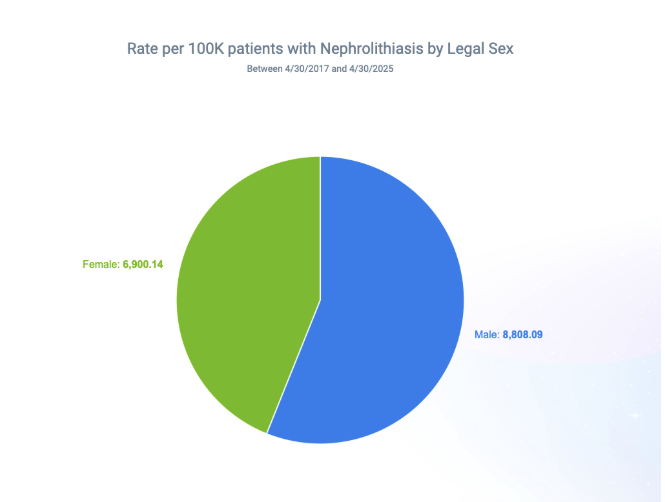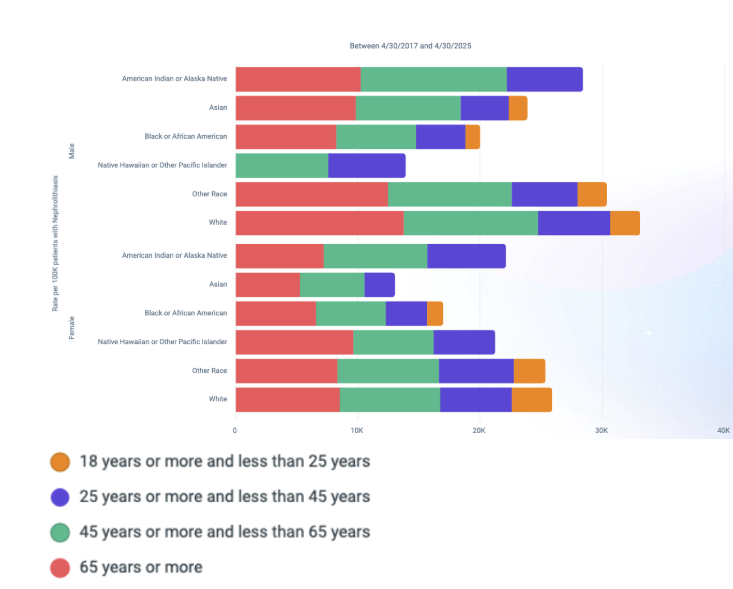Monday Poster Session
Category: IBD
P3274 - Racial Disparities and Demographic Profile of Nephrolithiasis Among Adults With Crohn’s Disease: A Multicenter Analysis Using Epic Cosmos Data
Monday, October 27, 2025
10:30 AM - 4:00 PM PDT
Location: Exhibit Hall

Archana Kharel, MD (she/her/hers)
Cleveland Clinic
Cleveland, OH
Presenting Author(s)
Archana Kharel, MD1, Prabhat Kumar, MD2, Mohamed Nadeem, MD3, Sasha Mangray, MD2, Stephen J. Bickston, MD, FACG4, Gengqing Song, MD, PhD5
1Cleveland Clinic, Cleveland, OH; 2Virginia Commonwealth University, Richmond, VA; 3Cleveland Clinic Foundation, Fairview Park, OH; 4Virginia Commonwealth University Health System, Richmond, VA; 5Case Western Reserve University/Metro Health, Cleveland, OH
Introduction: Patients with Crohn’s disease (CD) are at increased risk for nephrolithiasis due to multifactorial
etiologies including malabsorption, chronic inflammation, and altered oxalate handling.
However, population-level data on nephrolithiasis prevalence across demographic subgroups
within the Crohn’s population are limited. We aimed to determine the prevalence of
nephrolithiasis among adults with Crohn’s disease, stratified by race, legal sex, and age, using
real-world evidence from the Epic Cosmos data network.
Methods: This retrospective cohort study analyzed de-identified EHR data from Epic Cosmos, which
aggregates patient-level data across >200 U.S. health systems. We included adult patients (≥18
years) with a diagnosis of Crohn’s disease between April 30, 2017, and April 30, 2025.
Nephrolithiasis diagnoses were identified via problem list and encounter documentation.
Prevalence was expressed as percentages (rate per 100,000 divided by 1,000), stratified by race,
sex, and age bands.
Results: Among 7.7 million adults with Crohn’s disease, the overall prevalence of nephrolithiasis was
7.74%. Males had a higher prevalence (8.81%) compared to females (6.90%). White patients
with crohn’s disease exhibited the highest overall burden of nephrolithiasis at 8.28%, followed
by American Indian or Alaska native patients at 7.57%, and those identifying as other races at
7.48%. The lowest rates were observed in Asian patients (4.83%) and black or African American
patients (4.91%). Asian females had the lowest sex-specific prevalence at 3.79%.Prevalence
increased with age across all racial groups, peaking in the 75–84 year age group, with white
males reaching a maximum prevalence of 14.7%. These data suggest a significant nephrolithiasis
burden among aging Crohn’s populations, with distinct racial and sex-based disparities.
Discussion: In this large multicenter analysis of Crohn’s disease patients, nephrolithiasis affected nearly 1 in
13 individuals, with a disproportionate burden among older, white, and American Indian/Alaska
Native populations. These findings highlight the importance of kidney stone risk stratification in
Crohn’s care, particularly in aging male populations. Further studies are needed to assess
modifiable contributors and preventive interventions in high-risk groups.

Figure: Pie chart showing nephrolithiasis among adults with Crohn’s disease, stratified by legal sex

Figure: Bar diagram showing nephrolithiasis among adults with Crohn’s disease, stratified by race, and age
Disclosures:
Archana Kharel indicated no relevant financial relationships.
Prabhat Kumar indicated no relevant financial relationships.
Mohamed Nadeem indicated no relevant financial relationships.
Sasha Mangray indicated no relevant financial relationships.
Stephen Bickston indicated no relevant financial relationships.
Gengqing Song indicated no relevant financial relationships.
Archana Kharel, MD1, Prabhat Kumar, MD2, Mohamed Nadeem, MD3, Sasha Mangray, MD2, Stephen J. Bickston, MD, FACG4, Gengqing Song, MD, PhD5. P3274 - Racial Disparities and Demographic Profile of Nephrolithiasis Among Adults With Crohn’s Disease: A Multicenter Analysis Using Epic Cosmos Data, ACG 2025 Annual Scientific Meeting Abstracts. Phoenix, AZ: American College of Gastroenterology.
1Cleveland Clinic, Cleveland, OH; 2Virginia Commonwealth University, Richmond, VA; 3Cleveland Clinic Foundation, Fairview Park, OH; 4Virginia Commonwealth University Health System, Richmond, VA; 5Case Western Reserve University/Metro Health, Cleveland, OH
Introduction: Patients with Crohn’s disease (CD) are at increased risk for nephrolithiasis due to multifactorial
etiologies including malabsorption, chronic inflammation, and altered oxalate handling.
However, population-level data on nephrolithiasis prevalence across demographic subgroups
within the Crohn’s population are limited. We aimed to determine the prevalence of
nephrolithiasis among adults with Crohn’s disease, stratified by race, legal sex, and age, using
real-world evidence from the Epic Cosmos data network.
Methods: This retrospective cohort study analyzed de-identified EHR data from Epic Cosmos, which
aggregates patient-level data across >200 U.S. health systems. We included adult patients (≥18
years) with a diagnosis of Crohn’s disease between April 30, 2017, and April 30, 2025.
Nephrolithiasis diagnoses were identified via problem list and encounter documentation.
Prevalence was expressed as percentages (rate per 100,000 divided by 1,000), stratified by race,
sex, and age bands.
Results: Among 7.7 million adults with Crohn’s disease, the overall prevalence of nephrolithiasis was
7.74%. Males had a higher prevalence (8.81%) compared to females (6.90%). White patients
with crohn’s disease exhibited the highest overall burden of nephrolithiasis at 8.28%, followed
by American Indian or Alaska native patients at 7.57%, and those identifying as other races at
7.48%. The lowest rates were observed in Asian patients (4.83%) and black or African American
patients (4.91%). Asian females had the lowest sex-specific prevalence at 3.79%.Prevalence
increased with age across all racial groups, peaking in the 75–84 year age group, with white
males reaching a maximum prevalence of 14.7%. These data suggest a significant nephrolithiasis
burden among aging Crohn’s populations, with distinct racial and sex-based disparities.
Discussion: In this large multicenter analysis of Crohn’s disease patients, nephrolithiasis affected nearly 1 in
13 individuals, with a disproportionate burden among older, white, and American Indian/Alaska
Native populations. These findings highlight the importance of kidney stone risk stratification in
Crohn’s care, particularly in aging male populations. Further studies are needed to assess
modifiable contributors and preventive interventions in high-risk groups.

Figure: Pie chart showing nephrolithiasis among adults with Crohn’s disease, stratified by legal sex

Figure: Bar diagram showing nephrolithiasis among adults with Crohn’s disease, stratified by race, and age
Disclosures:
Archana Kharel indicated no relevant financial relationships.
Prabhat Kumar indicated no relevant financial relationships.
Mohamed Nadeem indicated no relevant financial relationships.
Sasha Mangray indicated no relevant financial relationships.
Stephen Bickston indicated no relevant financial relationships.
Gengqing Song indicated no relevant financial relationships.
Archana Kharel, MD1, Prabhat Kumar, MD2, Mohamed Nadeem, MD3, Sasha Mangray, MD2, Stephen J. Bickston, MD, FACG4, Gengqing Song, MD, PhD5. P3274 - Racial Disparities and Demographic Profile of Nephrolithiasis Among Adults With Crohn’s Disease: A Multicenter Analysis Using Epic Cosmos Data, ACG 2025 Annual Scientific Meeting Abstracts. Phoenix, AZ: American College of Gastroenterology.

